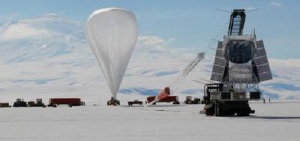Apr 9 2009
After two years spent analyzing data from BLAST, the Balloon-borne Large-Aperture Sub-millimeter Telescope, physicists are releasing the first results.
 This is the BLAST team in Antarctica. Credit: Mark Devlin and the University of Pennsylvania
This is the BLAST team in Antarctica. Credit: Mark Devlin and the University of Pennsylvania
The study, published in the current issue of Nature, reveals that the Far Infrared Background, or FIRB, originates from individual galaxies some 7 to 10 billion light years away.
The telescope, designed by a collaboration led by the University of Pennsylvania, collected data 120,000 feet above Antarctica in 2006. Flying the telescope above much of the atmosphere allowed the BLAST team to observe the distant universe at wavelengths nearly unattainable from the ground. The study has uncovered dust-enshrouded galaxies that hide about half of the cosmic starlight.
In the late 1990s, certain galaxies called Ultra-luminous Infrared Galaxies were found to be forming stars at a rate hundreds of times more than our own local galaxies. These "starburst" galaxies, 7-10 billion light years away, were thought to make up the FIRB, discovered by the COBE satellite. Since the initial measurement of this background radiation, higher-resolution experiments have tried to detect the individual galaxies that comprise it.
The BLAST study combines telescope survey measurements at wavelengths below 1 millimeter with data at much shorter infrared wavelengths from the Spitzer Space Telescope. The results confirm that all the Far Infrared Background comes from individual distant galaxies, essentially solving a decade-old question of the radiation's origin.
Star formation takes place in clouds composed of hydrogen gas and a small amount of dust. The dust absorbs the starlight from young, hot stars, heating the clouds to roughly 30 degrees above absolute zero, or 30 Kelvin. The light is re-emitted at much longer infrared and submillimeter wavelengths.
Thus, as much as 50 percent of the universe's light energy is infrared light from young, forming galaxies. In fact, there is as much energy in the Far Infrared Background as there is in the total optical light emitted by stars and galaxies in the Universe. While those familiar optical images of the night sky contain many fascinating and beautiful objects, they are missing half of the picture describing the cosmic history of star formation.
BLAST's extragalactic survey, taken at wavelengths of .25, .35 and .5 millimeters, provides new cosmological limits on the abundance and brightness of starburst galaxies for both the low- and high-redshift universe. The BLAST team chose to map a particular region of the sky called the Great Observatories Origins Deep Survey – South, or GOODS-South, which was studied at other wavelengths by NASA's Hubble, Spitzer and Chandra Space Telescopes. Comparing this submillimeter map with some of the deepest multi-wavelength data, the hidden properties of starburst galaxies can be deciphered.
Images, photographs, sky maps and the complete study are available at the BLAST website, http://www.blastexperiment.info
BLAST is an instrument with a 2-meter primary mirror along with a camera made of hundreds of bolometers, sensitive thermometers cooled to .3 degrees above absolute zero. With three wavelength bands operating, BLAST can determine the spectrum of submillimeter light coming from distant galaxies. In turn, this measurement gives the temperature of each galaxy and, ultimately, an estimate of its rate of star formation. The first sensitive, large-area submillimeter surveys of the universe required BLAST to fly suspended from a high-altitude balloon, soaring above 99.7 percent of the Earth's atmosphere. The dramatic journey from its first flight in the Arctic to the second flight in Antarctica was the subject of a feature-length documentary film, "BLAST!" (http://blastthemovie.com).
"For weeks in 2006 and early 2007, BLAST traveled over Antarctica making maps of the submillimeter sky," said Mark Devlin, Penn's Reese W. Flower Professor of Astronomy and Astrophysics and the project's principal investigator. "We measured everything from thousands of small clouds in our own galaxy undergoing star formation to galaxies in the universe when it was only a quarter of its present age."
In one epic 11-day balloon flight, BLAST found more than 10 times the total number of submillimeter starburst galaxies detected in a decade of ground-based observations. This rich data set is being mined for further information about these dust-enshrouded galaxies to give a better understanding of their evolutionary history, any relationship with other galaxies and associations with larger-scale structures in the universe. These results also provide catalogs of luminous submillimeter sources; combined with multi-wavelength data from other telescopes, astrophysicists can learn more about galaxy formation and evolution in the high-redshift universe.